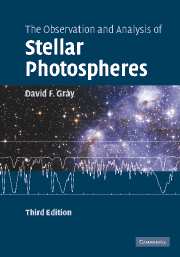Book contents
- Frontmatter
- Contents
- Preface to the first edition
- Preface to the second edition
- Preface to the third edition
- 1 Background
- 2 Fourier transforms
- 3 Spectroscopic tools
- 4 Light detectors
- 5 Radiation terms and definitions
- 6 The black body and its radiation
- 7 Radiative and convective energy transport
- 8 The continuous absorption coefficient
- 9 The model photosphere
- 10 The measurement of stellar continua
- 11 The line absorption coefficient
- 12 The measurement of spectral lines
- 13 The behavior of spectral lines
- 14 The measurement of stellar radii and temperatures
- 15 The measurement of photospheric pressure
- 16 Chemical analysis
- 17 Velocity fields in stellar photospheres
- 18 Stellar rotation
- Appendix A A table of useful constants
- Appendix B Physical parameters of stars
- Appendix C A fast Fourier transform Fortran program
- Appendix D Atomic data
- Appendix E The strongest lines in the solar spectrum
- Appendix F Computation of random errors
- Index
- References
8 - The continuous absorption coefficient
Published online by Cambridge University Press: 05 March 2015
- Frontmatter
- Contents
- Preface to the first edition
- Preface to the second edition
- Preface to the third edition
- 1 Background
- 2 Fourier transforms
- 3 Spectroscopic tools
- 4 Light detectors
- 5 Radiation terms and definitions
- 6 The black body and its radiation
- 7 Radiative and convective energy transport
- 8 The continuous absorption coefficient
- 9 The model photosphere
- 10 The measurement of stellar continua
- 11 The line absorption coefficient
- 12 The measurement of spectral lines
- 13 The behavior of spectral lines
- 14 The measurement of stellar radii and temperatures
- 15 The measurement of photospheric pressure
- 16 Chemical analysis
- 17 Velocity fields in stellar photospheres
- 18 Stellar rotation
- Appendix A A table of useful constants
- Appendix B Physical parameters of stars
- Appendix C A fast Fourier transform Fortran program
- Appendix D Atomic data
- Appendix E The strongest lines in the solar spectrum
- Appendix F Computation of random errors
- Index
- References
Summary
As a precursor to calculating the transfer of radiation through a model stellar photosphere, we now look at the continuous absorption coefficient. The wavelength dependence of the continuous absorption coefficient shapes the continuous spectrum emitted by the star: more absorption, less light. The strength of spectral lines also depends on the continuous absorption; more continuous absorption means a thinner photosphere with fewer atoms to make spectral lines. Consequently, we must know kν in order to match model-computed spectra to real stellar spectra. However, before we can compute the theoretical spectrum, we need to compute the model on which it is based, and that too can require kν. Specifically, if we invoke radiative equilibrium to find T(T0), then kν is needed from the very beginning. Furthermore, it then becomes particularly important to know kν in those spectral regions carrying most of the flux. In hot stars, this means the ultraviolet region, in cool stars, the infrared region. We escape this step if T(T0) is determined empirically, say by scaling the solar temperature distribution; the main need for kν reverts to the computation of the spectrum. Since scaled temperature distributions are emphasized in this book, kν in the visible window is the main focus of this chapter.
- Type
- Chapter
- Information
- The Observation and Analysis of Stellar Photospheres , pp. 147 - 169Publisher: Cambridge University PressPrint publication year: 2005



